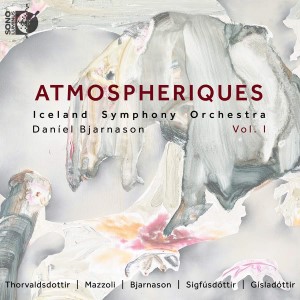
Atmospheriques Volume 1
Anna Thorvalsdottir (b. 1977)
Catamorphosis (2020)
Missy Mazzoli (b. 1980)
Sinfonia (for Orbiting Spheres) (2016)
Daniel Bjarnason (b. 1979)
From Space I Saw Earth (2019)
María Huld Markan Sigfúsdottir (b. 1980)
Clockworking for Orchestra (2020)
Bára Gisladóttir (1989)
ÓS (2018)
Icelandic Symphony Orchestra/Daniel Bjarnason, Eva Ollikainen, Kornilios Michailidis
Members of ISO Youth Orchestra
The Bell Choir of Reykjanesbær Music School
rec. 2021/22, Reykjavik, Iceland
Sono Luminus DSL-92267 [59]
The population of Iceland is around 372,000 – about a tenth the size of that of, for example, Wales. But there’s an awful lot happening on that island in music; last month, I reviewed a stunning disc of unaccompanied choral music from the Schola Cantorum Reykjavicensis (BIS-2618 – review), and now here is a highly impressive disc comprising five pieces of contemporary orchestral music. Four of the works are by Icelandic composers, one American; four of the works are by female composers (not the same four), one by a male.
Be warned, most of this music is quite dark; but it’s well worth sticking at it, because there is lots of terrific stuff here. The title that has been given to the CD, Atmospheriques, inevitably points us in the direction of György Ligeti, whose centenary is being widely celebrated this year. His 10-minute orchestral Atmosphères of 1961 was the piece which brought him to a wide public, largely through the use of it for an unforgettable sequence in Stanley Kubrick’s film 2001 – A Space Odyssey. It’s striking that two of the tracks here are works with a connection to outer space – Missy Mazzoli’s Sinfonia (for orbiting spheres) and Daniel Bjarnason’s From Space I saw Earth.
Ligeti’s masterpiece was remarkable for its sense of being overwhelmed by enormous spaces and forces beyond control. But he also employed the technique of shaping his music largely by the use of changing orchestral textures and colours. He also employed what he called ‘micropolyphony’, i.e. the combination of many small sounds. You will find both of those procedures in the works on this CD, notably Thorvadsdottir’s Catamorphosis and Bjarnason’s From Space.
Catamorphosis is the first piece on the disc. Not being familiar with the term, I looked up its definition, and found “evolutionary change based on or involving hypomorphosis”. This led me down a rabbit-hole, because I then needed to find out what ‘hypomorphosis’ was. So all I can say is ‘ask a physicist, or maybe a biologist’! But Thorvalsdottir’s work is a gripping one, in which huge complex instrumental clusters evolve and change, often coalescing into recognisable minor or major chords. Indeed, I felt a gravitational pull towards a C minor tonality; but that may just be me.
Missy Mazzoli’s Sinfonia (for orbiting spheres) is probably the most immediately enjoyable track. In part, this is because it has a very clear structure, with a slow, tentative opening that then moves into an agitated, quicksilver section, with snappy rhythms in muted trumpets. The scoring for a huge orchestra is wonderful, and unlike some contemporary composers, her grasp of orchestration extends to all sections of the orchestra – not just percussion! This piece was performed at the BBC Proms a couple of years back, and made a big impression.
Daniel Bjarnason, who conducts the other three works on this disc, is also a composer. His From Space I Saw Earth was written in 2019, in answer to a commission from the Los Angeles Philharmonic, for a concert celebrating the orchestra’s centenary. It divides its forces into three orchestras, each with its own conductor, and in the premiere, these roles were taken by the orchestra’s three most recent principal maestri, namely Gustavo Dudamel, Zubin Mehta and Esa-Pekka Salonen – a distinguished trio! For this recording, the conductors are, alongside Bjarnason, the Finn Eva Ollikainen, now the Iceland SO’s principal conductor, and Kornilios Michailidis, the brilliant young Greek pianist and conductor. Near the end, there is a wonderful passage where crotales (little brass bells often known as ‘antique cymbals’) are played by young musicians, on this recording members of the Iceland SO Youth Orchestra and the Bell Choir of Reykjanesbær, a town just along the coast from the capital. Thus this powerful piece moves through heavy extra-terrestrial zones, finally reaching a distant but beautiful expression of earthly music.
Clockworking by María Huld Markan Sigfúsdottir, the next track, might make you expect something along the lines of Steve Reich or Terry Riley. Well, you wouldn’t be completely wrong; eventually, Reich-like repeated patterns do merge in tuned percussion, although, Reich would never structure his music like this, as a long, laborious crescendo to a dead stop. Nevertheless, this is a compelling and convincing piece, if perhaps a little longer than it really needed to be.
Bára Gisladóttir, the composer of the final work, the mysteriously titled ÓS, does not seem a cheerful person. She has said that “..there is no hope for life – we have ruined the planet. It’s going to be a slow, Alzheimer’s-style end”, and something of that dark despair comes out in this brief but nihilistic work.
Not an ‘easy-listening’ disc, then. But enormously rewarding, brilliantly performed by the Iceland SO and other artists involved, and recorded with the utmost fidelity.
Gwyn Parry-Jones
Help us financially by purchasing from





















